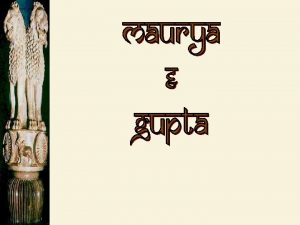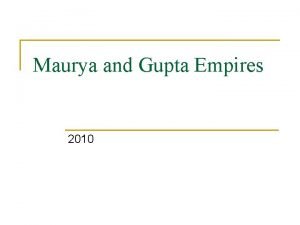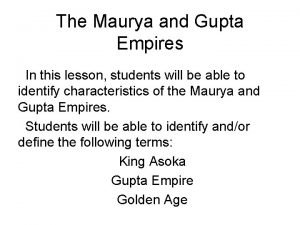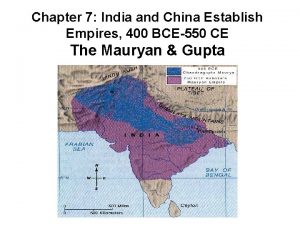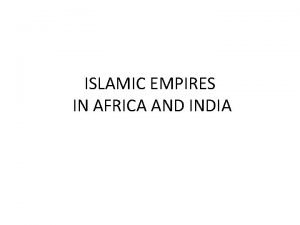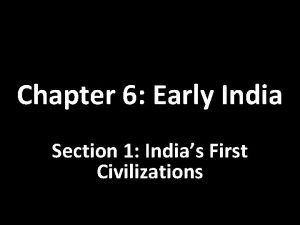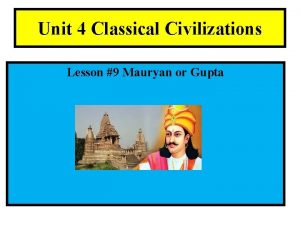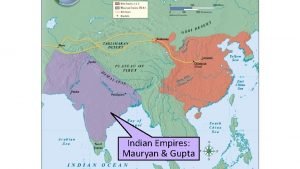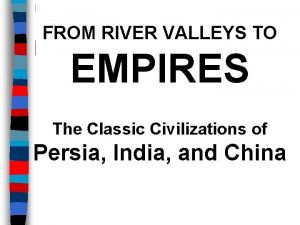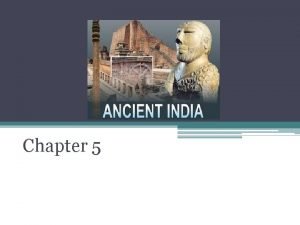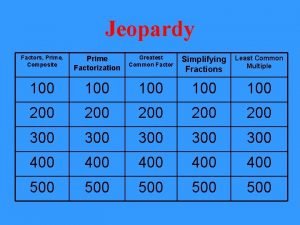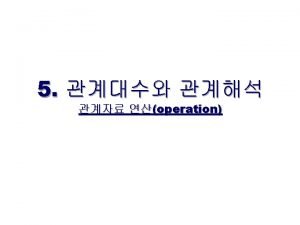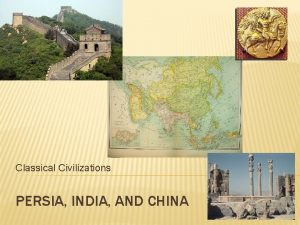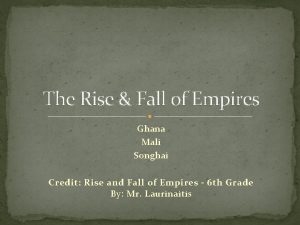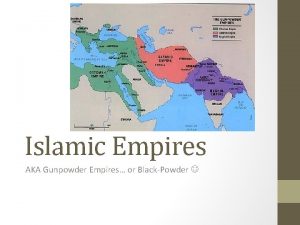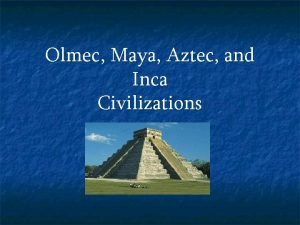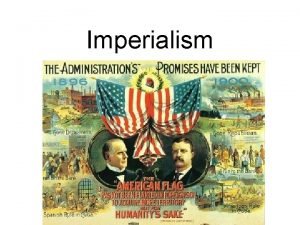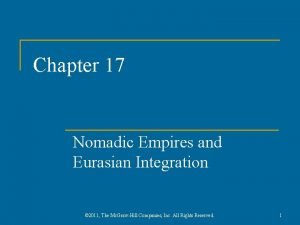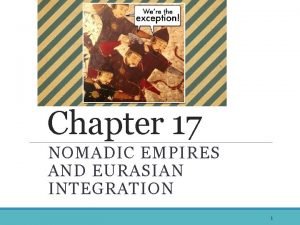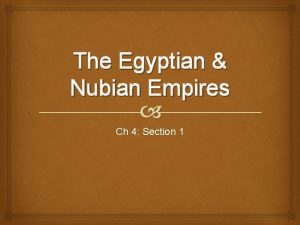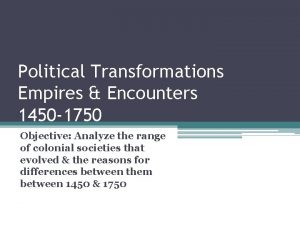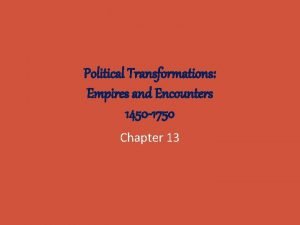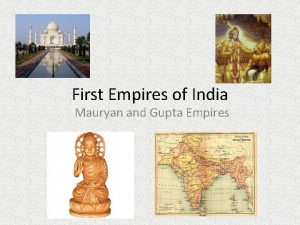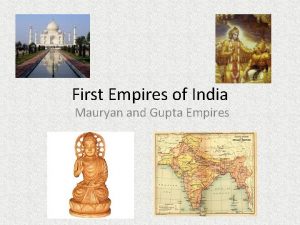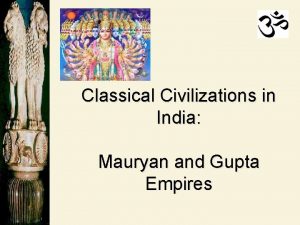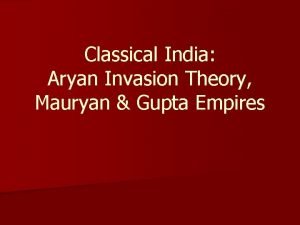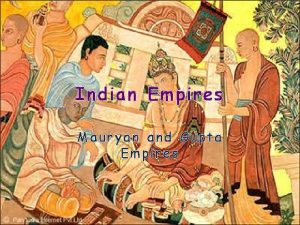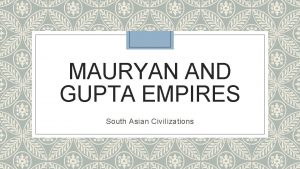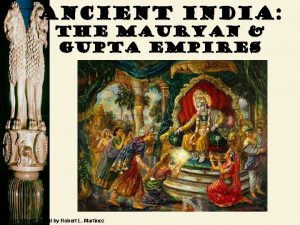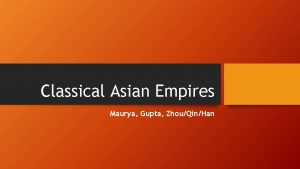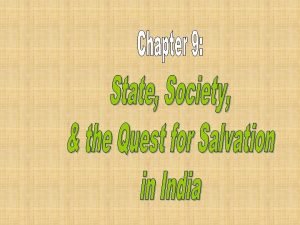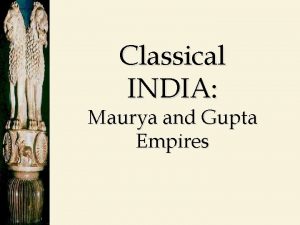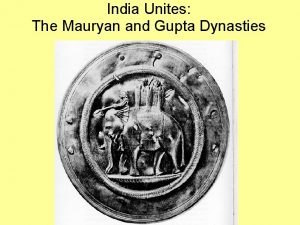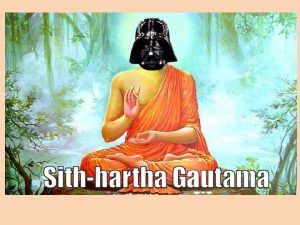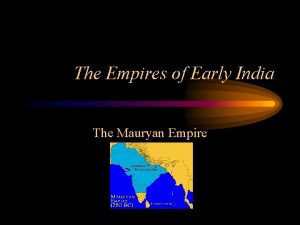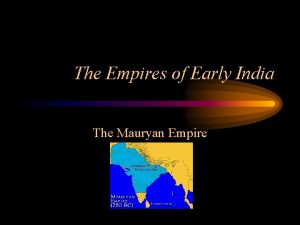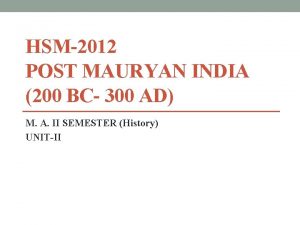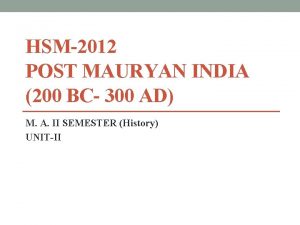Classical India The Mauryan and Gupta Empires 300









































- Slides: 41

Classical India The Mauryan and Gupta Empires 300 B. C. E. through 550 C. E.

We last looked in on India… • Aryans (named for their use of Sanskrit and other Indo-Aryan languages) • Arrived in waves from either central Asia or the Iranian plateau, mixed with local people and moved eastward to the Ganges by 1000 B. C. E. • Harrappa and Mohenjo Daro…?

We last looked in on India… • This culture is often called “Vedic” • What we know comes from the “Vedas” – sacred hymns • the Rig Veda

…much like China… • Empires will come and go but India will maintain a strong sense of cultural unity based on family bonds; social, economic and religious institutions.

VARNAS • Aryan society as portrayed in the Vedas was divided into classes called VARNAS • Based on functions fulfilled by their members in society

Brahmans • The most powerful varna was the Brahmans, the priests and leaders. • Perform religious rituals that allow all to gain favor with the gods • Only Brahman men were allowed to go to school, or to teach in schools (Brahman women could not go to school).

Kshatriya • The Kshatriya were warriors and landowners. • Served to protect society

Vaishyas • Vaishyas were the commoners • Farmers, Herders, Traders and merchants

Shudras • Consisted initially of conquered peoples that did menial labor • servants and farmhands who did not own their own business or their own land, and who had to work for other people. • Includes fishermen and artisans. • Most people belonged to this group

Emergence of CASTE • Interclass mobility and marriage fairly common • Class boundaries begin to blur • Upper class families fear loss of status – Prohibit marriage between classes – Refuse to socialize (even eat) with other classes • Solidification of a rigid class system known as CASTE

• Castes are exclusive and restrictive • Based on hereditary occupational grouping • People expected – fulfill their caste’s occupational function – Marry within caste – Share meals with caste – Observe caste’s traditional dress and behavior codes – Live with others of your caste

• There were also a lot of smaller groups within these castes. (JATIS) • Jatis became communities that identified with a certain trade in a certain locale and a particular god or goddess • Castes connected with religious notions of purity and pollution – Brahmins at the top. At the bottom…

Untouchables • Outside the Caste system (outcasts!) • Untouchables did the worst jobs, like cleaning up people's poop from the gutters, handling dead bodies or collecting garbage.

Caste System Pros and Cons • Restrictive? Limits freedom and mobility Provides stability Caste system seen as a vital cultural element that prevents chaos and disunity within society


• Religious beliefs (fostered by the Brahmins) centered on a universal spiritual force (Brahma) with a wide array of gods and rituals • 3 main concepts central to India’s worldview: Samsara (reincarnation) Dharma (faithful performance of your caste duties Karma (destiny based on your Dharma)

Post-Vedic India

Chandragupta Maurya: 321 BCE-298 BCE § Fills power vacuum left by the retreat of Alexander the Great §Creates first empire in India! §Justice of the Fish! § 301 BCE gave up his throne & became a pacifist §His son and grandson further expand the empire. .

The Mauryan Empire 321 BCE – 185 BCE

• Government’s job to provide opportunities for wealth (artha), pleasure (kama), fulfillment of social/religious duties (dharma) and (moksha) release from earth-bound existence • Men had power and responsibility of protecting women – women’s role? (nothing must be done independently) • Enforcing caste system

Asoka (304 – 232 BCE) § Chandragupta’s grandson §Military expansion §Religious conversion after the gruesome battle of Kalinga in 262 BCE. § Dedicated his life to Buddhism. – gives up hunting and meat § Built extensive roads and spread faith § built temples and shrines §Stone pillars with his edicts and buddhist teachings

Asoka’s Empire

Asoka’s law code § Edicts scattered in more than 30 places in India, Nepal, Pakistan, & Afghanistan. § Written mostly in Sanskrit, but some in Greek and Aramaic. §Each pillar [stupa] is 40’-50’ high. § Buddhist principles dominate his laws.

One of Asoka’s Stupas

Women Under an Asoka tree

Ashoka • Created a benevolent, paternalistic government • Devoted to welfare of his subjects (children) • Hospitals, wells, shade trees for pilgrims, maintained the shrines of other faiths • Vast army used force sparingly but the threat maintained peace

Turmoil & a power Vacuum: 220 BCE – 320 CE Mauryan Empire continues until 184 bce when its last ruler killed by one his own commanders Ta mi ls The Mauryan Empire is divided into many kingdoms.

Gupta Empire: 320 CE – 647 CE

Gupta Rulers § Chandra Gupta I v v r. 320 – 335 CE “Great King of Kings” Maharajadhira § Chandra Gupta II v r. 375 - 415 CE v Profitable trade with the Mediterranean world! § Hindu revival.

Chandra Gupta 11

Politics • Stability – religious tolerance and peace • Trade with the west flourished • Indirect rule • After military defeat, often withdrew and merely demanded tribute payments • Large amount of independence to administrators throughout government

Life in Gupta India § Chinese Buddhist monk traveled along the Silk Road and visited India in the 5 c. § He was following the path of the Buddha. § He reported the people to be happy, relatively free of government oppression, and inclined towards courtesy and charity. Other references in the journal, however, indicate that the caste system was rapidly assuming its basic features, including "untouchability, " the social isolation of a lowest class that is doomed to menial labor.

International Trade Routes during the Guptas

Extensive Trade: 4 c sp ic es rice & whea horses t vory i & gold ods o g on cott s silk ods o g on t t o c spices gold & ivory

Trade routes spread religion! Angkor Wat in Cambodia – the largest Hindu temple complex in the world…

Trade routes spread religion! The Longmen Grotto – located along the silk road in modern China, contains thousands of Buddhist carvings…

Gupta Art Greatly influenced Southeast Asian art & architecture.

500 healing plants identified 1000 diseases classified Printed medicinal guides Plastic Surgery Gupta Achievement s Kalidasa Literature Medicine Inoculations Gupta India C-sections performed Decimal System Mathematics Concept of Zero PI = 3. 1416 Solar Calendar Astronomy The earth is round

Women • Role of women continues to decline – Increasingly barred from religious and social activity – Forbidden to remarry – Confined to home and family

Sati • Extreme form of female subordination • Widows cremated themselves on their dead husbands’ funeral pyre

The Decline of the Guptas § Invasion of the Huns in the 4 c signaled the end of the Gupta Golden Age. § After the decline of the Gupta empire, north India broke into a number of separate Hindu kingdoms and was not really unified again until the coming of the Muslims in the 7 c. §
 Mauryan empire and gupta empire venn diagram
Mauryan empire and gupta empire venn diagram Mauryan and gupta empire map
Mauryan and gupta empire map The maurya and gupta empires
The maurya and gupta empires The maurya and gupta empires
The maurya and gupta empires The maurya and gupta empires
The maurya and gupta empires Maritime and land based empires
Maritime and land based empires Chapter 7 india and china establish empires
Chapter 7 india and china establish empires India empires
India empires Chapter 7 section 1 india's first empires
Chapter 7 section 1 india's first empires Chapter 7 section 1 india's first empires
Chapter 7 section 1 india's first empires Mauryan empire
Mauryan empire The mauryan empire
The mauryan empire Why mauryan empire decline
Why mauryan empire decline Mauryan people
Mauryan people How did the mauryan empire’s army help to promote trade?
How did the mauryan empire’s army help to promote trade? Harappan civilization
Harappan civilization 200+200+300
200+200+300 The prime factorization of 88 is
The prime factorization of 88 is 200+200+300+300
200+200+300+300 200 300 300
200 300 300 100+200+200
100+200+200 300+300+400
300+300+400 300+300+400
300+300+400 300+300+400
300+300+400 300+300+400
300+300+400 400 + 300 + 300
400 + 300 + 300 300 300 400
300 300 400 What is the font
What is the font 100 + 100 + 200
100 + 100 + 200 Post classical india
Post classical india What is it
What is it Classical india geography
Classical india geography Rise and fall of ghana empire
Rise and fall of ghana empire How did the ottoman safavid and mughal empires arise
How did the ottoman safavid and mughal empires arise Difference between aztecs and mayans
Difference between aztecs and mayans The policy of establishing colonies and building empires
The policy of establishing colonies and building empires Chapter 17 nomadic empires and eurasian integration
Chapter 17 nomadic empires and eurasian integration Chapter 17 nomadic empires and eurasian integration
Chapter 17 nomadic empires and eurasian integration Chapter 4 section 1 the egyptian and nubian empires
Chapter 4 section 1 the egyptian and nubian empires Political transformations empires and encounters
Political transformations empires and encounters Chapter 5 political transformations empires and encounters
Chapter 5 political transformations empires and encounters Gunpowder empires characteristics
Gunpowder empires characteristics
